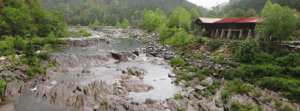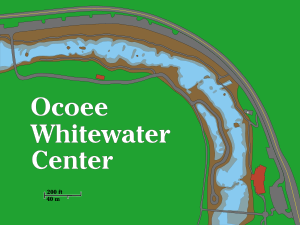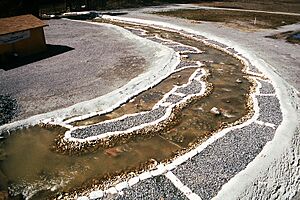Ocoee Whitewater Center facts for kids
 |
|
| About | |
|---|---|
| Locale | Ducktown, Tennessee, United States |
| Managing agent | U S Forest Service |
| Designer | McLaughlin Whitewater Design Group |
| Main shape | Riverbed |
| Water source | Ocoee River Dam release |
| Surf wave | Yes |
| Canoe lift | No |
| Facilities | Yes, limited due to fire |
| Construction | 1993-95 |
| Opening date | 1996 |
| Stats | |
| Length | 1,640 feet (500 m) |
| Drop | 37 feet (11 m) |
| Slope | 2.2% (120 ft/mile) |
| Flowrate | 1,400 cu ft/s (40 m3/s) to 1,600 cu ft/s (45 m3/s) |
| Ocoee Whitewater Center | |
The Ocoee Whitewater Center is a super cool place near Ducktown, Tennessee, in the United States. It was once the stage for the canoe slalom event during the 1996 Summer Olympics in Atlanta. What makes it really special is that it's the only Olympic course ever built right in a natural river!
To create the perfect Olympic course, a 1,640-foot (500 m) part of the Upper Ocoee River was made narrower. This created exciting drops and swirling eddies that canoeists needed to navigate. Today, the river only gets water on summer weekends, about 34 days a year. During these times, lots of guided rafts and private boats come to enjoy the rapids. Over 24 companies bring more than 750 people down the river every day!
Since the river is dry for most of the year, the Center, now run by the U.S. Forest Service, offers other fun activities. You can go hiking, mountain biking, or even hold meetings and weddings there. About 300,000 people visit the Center each year.
Sadly, the main visitor center building was destroyed by a fire on April 26, 2022. Investigators are still trying to figure out what caused it. But don't worry, the day-use area of the Center reopened on May 27, 2023, and the U.S. Forest Service is planning how to make the Center even better for the future.
Contents
Building an Olympic River Course
Canoe slalom is a newer sport in the Olympics. Most cities that host the games don't have natural rivers with fast-moving water nearby. So, the first Olympic canoe slalom courses were man-made canals built around dams. The Ocoee Whitewater Center was different because it used a real riverbed!
For the 1996 Atlanta Games, they changed the dry streambed of the Upper Ocoee River. This made it the only Olympic venue built in a natural river. It had more water, a bigger drop, and a steeper slope than other courses. Newer Olympic courses are often built closer to cities and use pumps to move water through smaller concrete channels. This helps save energy.
To make the Ocoee River perfect for the Olympics, engineers built walls along the sides. These walls, covered with natural rocks, made the river narrower. It went from about 200 feet (61 m) wide to 70 feet (21 m) wide. Even at this smaller size, it was still twice as wide as most man-made whitewater channels! To make the water flow just right, they needed a lot of water, about 1,400 cubic feet per second (40 m³/s). This is two or three times more water than most artificial channels use.
Before they started building, they even made a small model of the river, one-tenth the actual size. They tested the proposed changes with water on this model to make sure everything would work.
Using the Ocoee River for fun means less electricity can be made. The Upper Ocoee River usually doesn't have much water because it's sent through tunnels to a powerhouse to create electricity. When water is released into the river for rafting or events, it bypasses the powerhouse. This means the power company, the Tennessee Valley Authority, loses out on making electricity. For the Olympics, releasing water meant losing enough electricity to power many homes! Today's recreational releases also mean a loss of electricity, which costs money.
Luckily, the popular rafting industry brings in enough money to help pay the Tennessee Valley Authority for this lost electricity. But for athletes who need to practice, it can be expensive. That's why places like the U.S. National Whitewater Center in Charlotte, North Carolina, were built. It has an Olympic-standard course that uses pumps to move water, making it easier for athletes to train.
The building that once hosted media and VIPs for the Olympic events now serves as a visitor center and gift shop.
The Olympic Race Course
For the final canoe slalom race at the 1996 Olympics, there were 25 gates. Six of these were upstream gates (marked red), and 19 were downstream gates (marked green). The course was 500 meters long, which was twice as long as the course used in the 2012 London Olympics.
Racers had to paddle really fast between the gates at the top of the course. Then, they had to be super skilled to steer through the closely spaced gates around a famous rapid called Humongous at the bottom.
Some of the exciting rapids on the course have names like Best Ledge, Smiley’s, Slam Dunk, and the Conveyor Belt wave train. Callihan Ledge is another one, leading to the most challenging part: Humongous.
Humongous is the steepest and narrowest rapid. It has a big wave train on one side of a boulder and two large drops on the other side, called Godzilla and Humongous Hole. Olympic racers had to be very careful here. They needed to use the Godzilla wave to stop their boat and then surf across the current to get through the gates without getting stuck.
Commercial rafts often go down the right side of Humongous for a thrilling two-drop ride. Sometimes, this ride is so exciting that people might even flip out of their rafts and into the water!
The Ocoee Whitewater Center was supposed to host the ICF Canoe Slalom World Championships in 2001, but those events were cancelled.
Ocoee Whitewater Rafting Fun
Whitewater rafting on the Middle Ocoee River, which is downstream from the Whitewater Center, became really popular starting in 1976. This happened when a wooden channel, called a flume, was shut down for repairs. This flume usually carried water away from the river to make electricity, leaving the riverbed dry.
From 1913 until 1976, the 4.5-mile (7.2 km) section of the river below the flume was mostly dry, especially in summer. But when the flume closed for repairs in 1976, water suddenly flowed back into the Middle Ocoee. This attracted private canoeists, kayakers, and commercial rafting companies. By 1983, when the flume was fixed, these rafting groups had become so popular that they made a deal with the TVA. This deal ensured that water would be released into the river regularly during the summer months for recreation. Thirteen years later, when the 1996 Olympics came to the Upper Ocoee, recreational water releases were also scheduled for that part of the river.
Today, thanks to a 13-year agreement, the Upper Ocoee River, where the Whitewater Center is, gets water for rafting on summer weekends, about 34 days a year. The Middle Ocoee River gets water for 106 days a year and has 26 exciting rapids! On days when the Upper Ocoee also has water, the Middle Ocoee gets even more water, lasting into the early evening. Most rafting happens on the Middle Ocoee, but rafting the Upper Ocoee, with its steeper Olympic course, is offered as a more challenging adventure.
The best part is that whenever the Ocoee River has water, private boaters can use it for free!
Hiking, Biking, and Camping Adventures
The Tanasi Trail System is a fantastic place for mountain biking, with 30 miles (48 km) of trails that start around the Whitewater Center. If you want to stay overnight, the Thunder Rock Campground is just one mile (1.6 km) west of the Center.
The Ocoee Scenic Byway (U.S. 64) is a beautiful road that leads to the Center and is usually open all year. The westbound lanes of this road were actually built as a parking and staging area for the Olympics. This helped it become a divided highway, making it easier to handle all the cars during busy summer times.
Images for kids








